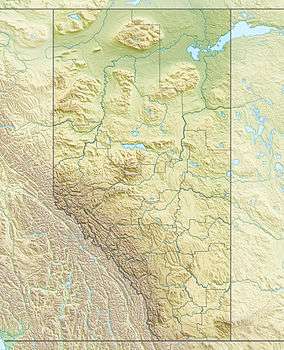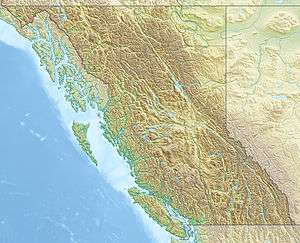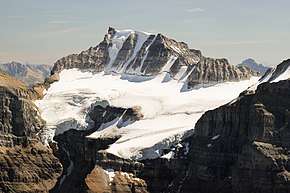Mount Fay
Mount Fay is a mountain located on the border of Alberta and British Columbia on the Continental Divide in the Canadian Rockies. The mountain forms part of the backdrop to Moraine Lake in the Valley of the Ten Peaks of Banff National Park. It was named in 1902 by Charles E. Fay, an early explorer of the Canadian Rockies. He was a member of the party who attempted Mount Lefroy in 1896 when the first mountaineer to be killed in the Canadian Rockies occurred.[1]
| Mount Fay | |
|---|---|
 Mount Fay seen from Moraine Lake | |
| Highest point | |
| Elevation | 3,235 m (10,614 ft) [1] |
| Prominence | 389 m (1,276 ft) [2] |
| Parent peak | Mount Allen 3280 m[2] |
| Coordinates | 51°17′58″N 116°09′43″W [3] |
| Geography | |
 Mount Fay Location on Alberta and British Columbia border  Mount Fay Mount Fay (British Columbia) | |
| Country | Canada |
| Provinces | Alberta and British Columbia |
| National Park | Banff |
| Parent range | Bow Range |
| Topo map | NTS 82N/08 |
| Climbing | |
| First ascent | 1904 Gertrude Benham, Christian Kaufmann[1] |
| Easiest route | South-West Face |

Notable ascents
- 1937 December 22 First winter ascent by E.R. Gibson, Doug Crosby, and Bob Hind[4]
- 1984 East Face (V/VI 5.8 WI5) FA by Barry Blanchard, David Cheesmond and Carl Tobin.[5] Repetition of the East Face and variation on the finish was done from 2 - 3 April 2019 by Brette Harrington, Luka Lindič and Ines Papert.[6]
Geology
Like other mountains in Banff Park, Mount Fay is composed of sedimentary rock laid down during the Precambrian to Jurassic periods.[7] Formed in shallow seas, this sedimentary rock was pushed east and over the top of younger rock during the Laramide orogeny.[8]
Climate
Based on the Köppen climate classification, Mount Fay is located in a subarctic climate with cold, snowy winters, and mild summers.[9] Temperatures can drop below −20 C with wind chill factors below −30 C.
See also
- List of peaks on the British Columbia-Alberta border
- List of mountains of Alberta
- Mountains of British Columbia
References
- "Mount Fay". PeakFinder.com. Retrieved 2019-08-17.
- "Mount Fay". Bivouac.com. Retrieved 2010-02-12.
- "Mount Fay". Geographical Names Data Base. Natural Resources Canada. Retrieved 2013-05-18.
- Gibson, E.R. (June 1938). "First Winter Ascent of Mt. Fay". Canadian Alpine Journal. Alpine Club of Canada. XXV (1937): 93. Retrieved 2019-08-19.
- Blanchard, Barry (Summer 2011). "Sanctum". Alpinist. Jeffersonville, VT, USA: Height of Land Publications. 2011 (35): 68–73. ISSN 1540-725X.
- "Harrington, Lindič and Papert Complete First Integral Ascent of Mt. Fay's East Face". Rock and Ice. Retrieved 2019-11-12.
- Belyea, Helen R. (1960). The Story of the Mountains in Banff National Park (PDF). parkscanadahistory.com (Report). Ottawa: Geological Survey of Canada. Archived (PDF) from the original on 2015-10-02. Retrieved 2019-09-13.
- Gadd, Ben (2008). "Geology of the Rocky Mountains and Columbias". Missing or empty
|url=(help) - Peel, M. C.; Finlayson, B. L. & McMahon, T. A. (2007). "Updated world map of the Köppen−Geiger climate classification". Hydrol. Earth Syst. Sci. 11: 1633–1644. ISSN 1027-5606.
Further reading
- Dave Birrell, 50 Roadside Panoramas in the Canadian Rockies, PP 86 - 87
- Maurice Isserman, Continental Divide: A History of American Mountaineering